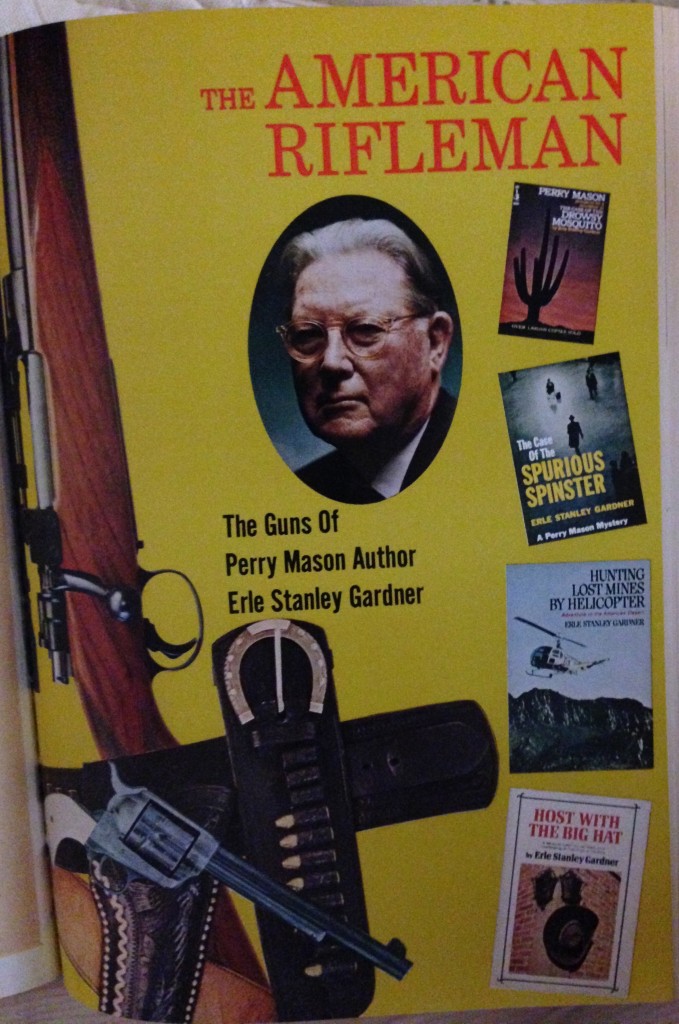This one is a little unusual.
I find Erle Stanley Gardner (or, as he is often called, “ErleStanleyGardnerTheCreatorOfPerryMason”, all one word) to be a fascinating person.
I’m not very well read in the Perry Mason books; I should perhaps give them another try, but it seems to me that Gardner’s style in those books was somewhat arch and stilted. I think I’ve read a couple of the A.A. Fair books that my mother had lying around the house when I was younger, but I don’t really recall those.
I’m more interested in Gardner as a non-fiction writer. I’ve written about this elsewhere, but his book The Court of Last Resort (based in part on his experiences with the organization of the same name) contains what I believe is some of the smartest and sanest writing about crime and criminal justice ever. There are things in there (especially about drug policy) that still hold up nearly 60 years after the book was written.
Lawrence and I have periodically discussed the idea of putting together a collection of Gardner non-fiction firsts. In addition to his writing about criminal justice, he also wrote about exploring Baja by jeep, Hunting Lost Mines by Helicopter, and other outdoors subjects. Copies of his non-fiction books show up pretty regularly on the Internet auction sites, sometimes even signed, but I have yet to find one that’s in good enough condition to justify Heritage’s minimum $15 price.
I think that’s one of the reasons I’m so fascinated by Gardner: he was certainly a hellaciously smart man, and no slouch as a lawyer, but he was also a serious outdoorsman, and he blended both sides of his character well. (The “Court of Last Resort” actually got started around the campfire one night on one of Gardner’s Baja trips; one of his campfire companions was the publisher of Argosy, who listened to Gardner’s account of the Lindley case and promised him space in the magazine for any additional cases where Gardner felt an innocent man had been convicted.)
(As a side note, we could really use a contemporary “Court of Last Resort”. We could also use more public intellectuals like Erle Stanley Gardner.)
====
Last weekend, I was poking around at one of the Half-Price Books locations and found something that intrigued me: two bound volumes of the American Rifleman from 1971 and 1973. This is close to the time when I started reading AR (Dad had a stack of old ones in the garage, and I was a precocious child), and I still have a fondness for the magazine of that era.
So I started flipping through the bound volumes, and ran across this cover story from the May 1971 issue:
“Well. Well well well. Well.” said I.
(I apologize for the kind of crappy photo. These bound volumes run at about two ox-stunning units, and are very hard to get on a scanner.)
The cover story is a tribute to Gardner, who was also an NRA member, and who had passed away about a year previously. The two guns on the cover were donated by his wife to the NRA Museum. The handgun is a Colt Single Action Army in .45 Colt; it and the leather were given to him by a client in a shooting case. (Gardner won an acquittal.) The rifle is an early Weatherby in .300 Weatherby Magnum, using a Mauser action (instead of the Weatherby Mark V action used in later rifles).
There are a few interesting bits of trivia in the AR tribute that I wasn’t aware of:
- Gardner was so accurate with a rifle that he gave up using firearms for hunting for a long period of time. Instead, he did his deer hunting with a bow and arrow.
- In his 70s, Gardner set out to prove that a person with a .22 handgun could survive indefinitely on the small game he could harvest “within 300, 200, or even 100 miles of Los Angeles.” This became a three-part article for Sports Afield. (I dare you to try that today.)
- “He had a habit of racking .22 tubular-magazine rifles with the magazines pulled partway out.” He also liked inexpensive guns, probably (as the article notes) because his guns were working guns for his ranch, not safe queens.
- Gardner invented “archery golf”: “Players were allowed so many shots with a bow and arrow to get up to a hole – actually, a paper sack on a pole. Each player then made the hole by shooting an arrow through the paper sack.”
What I find even more interesting than the tribute is that the American Rifleman also reprinted a Gardner essay: “Why Gun Registration Can’t Cut Crime”. I can’t find it online, but it is in another essay collection, Cops on the Campus and Crime in the Streets.
There is an old expression which somehow indicates the subconscious thinking of the American people. It starts out, “There ought to be a law against…”
Whenever the American people want to stop something they want a law prohibiting the thing they want stopped, as if laws in themselves were a solution.
Gardner’s essay goes on from there, outlining the flaws in gun registration laws. (Why would a criminal register their guns? How do you deal with the registration information and keep it secure?)
We aren’t going to disarm the criminal. We may as well make up our minds to that right at the start. We can try to do it, but the criminal is going to be armed. The man who needs a gun in order to perpetrate a holdup is going to have a gun.
I’m used to finding that people whose work I generally like have big blind spots in certain areas, especially guns. It perhaps should not have come as a surprise, but it is refreshing to me that Gardner was as wise and sane about gun politics as he was about other aspects of criminal justice.
